- Clone
- 9C8B50 (See other available formats)
- Regulatory Status
- RUO
- Other Names
- Signal transducer and activator of transcription 5A
- Isotype
- Mouse IgG2a, κ
- Ave. Rating
- Submit a Review
- Product Citations
- publications
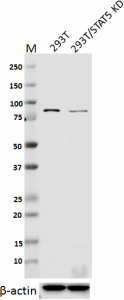
-

Total lysates (15 µg protein) from 293T and 293T/STAT5 knockdown (KD) cells were resolved by electrophoresis (4-20% Tris-Glycine gel), transferred to nitrocellulose, and probed with 1:250 diluted (2 µg/mL) purified anti-STAT5 antibody, clone 9C8B50 (upper). Proteins were visualized using chemiluminescence detection by incubating with 1:3000 dilution of HRP goat anti-mouse-IgG secondary antibody (Cat. No. 405306). 1:2000 dilution of Direct-Blot™ HRP anti-β-actin Antibody (Cat. No. 643807) was used as a loading control (lower). Lane M: MW ladder. -

Total lysates (15µg protein) from Jurkat (lane1), PC3 (lane 2) and Raw264.7 (lane 3) cells were resolved by electrophoresis (4-20% Tris-Glycine gel), transferred to nitrocellulose, and probed with 1:1000 diluted (0.5 µg/mL) Purified anti-STAT5 Antibody, clone 9C8B50 (upper). Proteins were visualized by chemiluminescence detection using a 1:3000 diluted anti-Mouse-IgG secondary antibody conjugated to HRP for the anti-STAT5 Antibody or 1:5000 diluted Direct-Blot™ HRP anti-β-Actin Antibody, clone 2F1-1(lower). Lane M: Molecular weight ladder. -

Hela cells were fixed with 2% paraformaldehyde (PFA) for 10 minutes, permeabilized with 0.5% Triton X-100 for 5 minutes, and blocked with 5% FBS for 30 minutes. Then the cells were intracellularly stained with 2.5 µg/mL anti-STAT5 Antibody (9C8B50) and followed by DyLight™ 594 goat anti-mouse IgG (red) for 1 hour at room temperature. Actin filaments were labeled with Alexa Fluor® 488 Phalloidin (green). Nuclei were counterstained with DAPI (blue). The image was captured with a 40X objective. -

Immunoprecipitation of STAT5 from Jurkat cell extracts. Lane 1 is 8% input. Immunoprecipitation was performed using protein G resins only (lane 2), mouse IgG isotype control (lane 3), and anti-STAT5 antibody (clone 9C8B50, lane 4). Western blot was performed using anti-STAT5 antibody (clone 9C8B50).
| Cat # | Size | Price | Quantity Check Availability | Save | ||
|---|---|---|---|---|---|---|
| 660202 | 100 µg | 300 CHF | ||||
STAT5 is a member of the signal transducer and activator of transcription factors (STAT) family, mediating growth and cytokine signaling. STAT5 consists of two closely related family members, STAT5A and STAT5B, which exhibit 96% sequence homology and are functionally redundant. Upon activation, STAT5 is phosphorylated by receptor tyrosine kinases and, in turn, forms homodimers or hererodimers with other family members through its SH2 domains. The dimerized STAT5 translocates to the nucleus and binds to the STAT5 response element (TTCXXXGAA). STAT5 plays crucial regulatory roles in cell proliferation, anti-apoptosis, early B cell differentiation, and T cell development.
Product DetailsProduct Details
- Verified Reactivity
- Human, Mouse
- Antibody Type
- Monoclonal
- Host Species
- Mouse
- Immunogen
- Partial human STAT5A recombinant protein (627-794 a.a.) expressed in E. coli.
- Formulation
- This antibody is provided in phosphate-buffered solution, pH 7.2, containing 0.09% sodium azide.
- Preparation
- Affinity purified.
- Concentration
- 0.5 mg/ml
- Storage & Handling
- Upon receipt, store undiluted between 2°C and 8°C.
- Application
-
WB - Quality tested
KO/KD-WB, ICC, IP - Verified - Recommended Usage
-
Each lot of this antibody is quality control tested by Western blotting. For Western blotting, the suggested use of this reagent is 0.1 - 2.0 µg per ml. For immunocytochemistry, the suggested use of this reagent is 1.0 - 5.0 µg per ml. For immunoprecipitation, the suggested use of this reagent is 2.0 - 10.0 μg per ml. It is recommended that the reagent be titrated for optimal performance for each application.
- Application Notes
-
This clone is not recommended for ChIP (Chromatin Immunoprecipitation) assays (as determined by in-house testing).
- Product Citations
-
- RRID
-
AB_2563469 (BioLegend Cat. No. 660202)
Antigen Details
- Structure
- 794 amino acids, predicted molecular weight of 91 kD; contains a SH2 domains responsible for homodimerization or heterodimerization.
- Distribution
-
Cytoplasm; phosphorylated form translocates to the nucleus.
- Function
- STAT5 is a transcription regulator and is involved in cell differentiation, proliferation, and survival, in response to several cytokines, such as interleukins, erythropoietin, growth hormone, thrombopoietin, and prolactin.
- Interaction
- Forms a homodimer or a heterodimer with other family members. Interacts with NCOA1, SOCS7, CBP, p300, SMRT and ERBB4.
- Cell Type
- B cells, Tregs
- Biology Area
- Apoptosis/Tumor Suppressors/Cell Death, Cell Biology, Cell Cycle/DNA Replication, Immunology, Signal Transduction, Transcription Factors
- Molecular Family
- Nuclear Markers
- Antigen References
-
1. Bell BD, et al. 2013. Nat. Immunol. 14:364.
2. Cholez E, et al. 2012. Leukemia. 26:2390.
3. Heltemes-Harris LM, et al. 2012. Curr. Opin. Immunol. 24:146.
4. Heltemes-Harris LM, et al. 2011. Ann. N Y Acad. Sci. 1217:18.
5. Malin S, et al. 2010. Curr. Opin. Immunol. 22:168.
6. Xu J, et al. 2009. J. Neurosci. 29:2022. - Gene ID
- 6776 View all products for this Gene ID
- UniProt
- View information about STAT5 on UniProt.org
Related FAQs
Other Formats
View All STAT5 Reagents Request Custom Conjugation| Description | Clone | Applications |
|---|---|---|
| Purified anti-STAT5 | 9C8B50 | WB,ICC,IP |
| Direct-Blot™ HRP anti-STAT5 | 9C8B50 | WB |
Customers Also Purchased
Compare Data Across All Formats
This data display is provided for general comparisons between formats.
Your actual data may vary due to variations in samples, target cells, instruments and their settings, staining conditions, and other factors.
If you need assistance with selecting the best format contact our expert technical support team.
-
Purified anti-STAT5
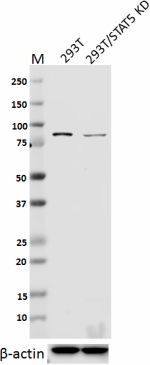
Total lysates (15 µg protein) from 293T and 293T/STAT5 knock... 
Total lysates (15µg protein) from Jurkat (lane1), PC3 (lane ... 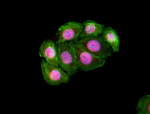
Hela cells were fixed with 2% paraformaldehyde (PFA) for 10 ... 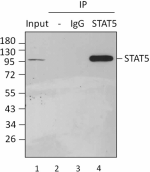
Immunoprecipitation of STAT5 from Jurkat cell extracts. Lane... -
Direct-Blot™ HRP anti-STAT5

10 µg of total protein extract from Jurkat cells was resolve...
 Login / Register
Login / Register 






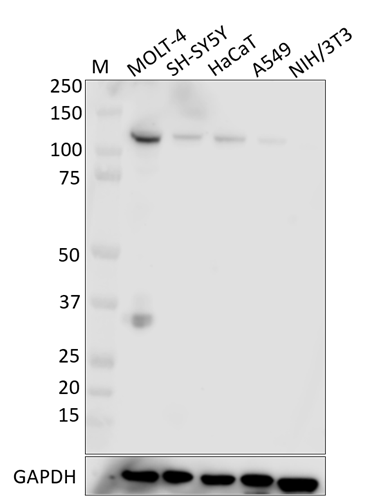




Follow Us